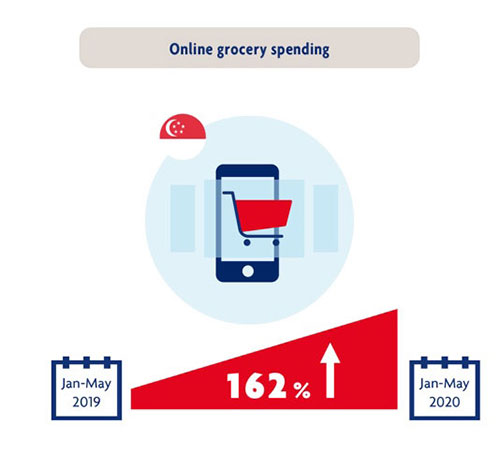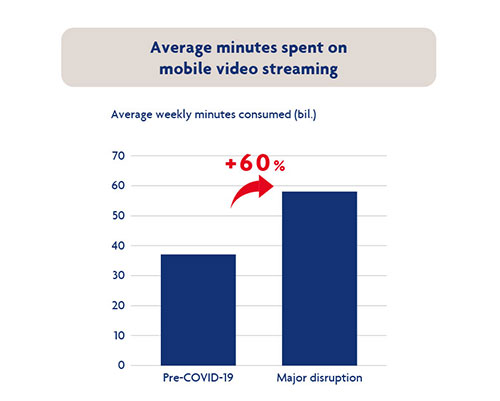Key takeaways
- Revenue opportunities have accelerated in areas such as e-commerce, e-gaming, telemedicine and cloud-based solutions as the COVID-19 pandemic transforms the way we live, work and play.
- Companies that digitalise further – not just in their business model, but also their operating methods – will be able to adapt more effectively to the change in consumption trends.
- Those that fail to transform risk falling further behind as we progress into the digital
Faced with the need to cope with the measures implemented by their respective governments to contain the spread of COVID-19, people have had to make changes to the way they live, work and play. These include the shift towards e-commerce as consumers take to the convenience of buying what they need from the comfort of their homes. Such behavioural changes have also given rise to new business opportunities and we take a look at four areas where businesses can seize new opportunities for revenue growth:
Accelerated shift to e-commerce led by online grocery sales
As more people stayed home to prevent the spread of COVID-19, there has been an accelerated shift towards online shopping and in particular, grocery spend. According to data from UOB, online grocery spending in Singapore increased by 162 per cent from January to May 2020 as compared with the same period in 2019. Across ASEAN, there are also similar trends among consumers, with a report from Facebook and Bain & Company stating that at least 44 per cent of digital consumers across Southeast Asia have spent more on packaged and fresh groceries online. Among these consumers, at least 80 per cent also indicated they have plans to continue buying groceries online in the future.

In the first five months of 2020, online grocery spending rose by 162 per cent as compared with the year before. Source: UOB
To meet the growing demand for online grocery shopping in the region, Grab expanded its grocery delivery platform, GrabMart, to 50 cities in ASEAN. They have also partnered with more than 3,000 convenience stores, supermarkets and even traditional markets so that they can offer customers with more options when it comes to fulfilling their grocery shopping needs.
Data from major e-commerce platforms show that online shopping has continued to take root in this region. Singapore’s leading e-commerce platform, Qoo10, saw a 70 per cent increase in the number of cart checkouts and a 36 per cent increase in new account sign-ups for the first six months of 2020 as compared with the same period last year.
According to its chief executive officer, Mr Ku Young Bae, growth in Singapore peaked in May, as physical retail outlets remained shut due to the circuit breaker extension to 1 June.
"We felt heartened seeing more new users from the older demographic as well as existing users make their first purchases in the food categories,” Mr Ku said. “These are important milestones that bode well for Singapore’s e-commerce market and we expect to see an overall growth of between 30 to 45 per cent increase in total volume of goods sold for 2020."

Mr Ku Young Bae, CEO of Qoo10, said that the e-commerce platform expects to see a 30 to 45 per cent growth in total volume of goods sold for 2020. Photo: Qoo10
As more people turn to online shopping for their day-to-day needs, companies that transform their business models to seize online opportunities will be able to seek further revenue growth. They will also be able to diversify their revenue streams to improve business resilience in the long-term.
Growing digital media consumption in the region
Demand for online entertainment has also soared since the COVID-19 outbreak. According to a report by Media Partners Asia, the time spent on online video streaming on mobile grew by 60 per cent across markets in Southeast Asia. Netflix, a subscription-based video streaming services provider, saw its new subscribers in Asia Pacific grow by 3.6 million to 19.84 million in the first quarter of 2020. Total hours watched on live-streaming platform Twitch has doubled year-on-year as viewers followed by e-sports and gaming live streams.

Users across Southeast Asia spent more time streaming videos on their mobile devices following stay-at-home orders in the first quarter of the year.
The video games market has also grown, registering higher sales. Sales of Nintendo’s latest instalment of Animal Crossing hit a record of more than 1.8 million copies in three days in Japan. Asia is the world’s biggest video game market, contributing towards half of the US$159 billion global gaming market in 2020.
Increased viewership has driven development and investments in cloud and mobile content delivery. Local players in the region such as Vidio in Indonesia, iWant in the Philippines, meWatch in Singapore and LineTV in Thailand have seen significant growth in viewership numbers. Livestreaming has also become a key part of e-commerce platform Lazada’s ‘shoppertainment’ strategy.
The region’s growth in online media consumption creates opportunities for businesses in the areas of digital content creation, streaming services and video games development. Companies may also consider how they can leverage these trends to engage their customers or to shape their marketing efforts.
Healthcare from a distance
Telemedicine played an important role during the pandemic. Medical professionals were able to provide consultation and prescriptions to patients remotely via secure video or audio connections, reducing the need for patients to visit a clinic or hospital.
Singapore-headquartered Doctor Anywhere is a telemedicine service provider that experienced a surge in consultation demand during the pandemic. Since the start of the pandemic till June 2020, overall usage on its telemedicine platform increased almost four-fold. Consultations for chronic medication refills grew nine times in the same period.
In response to the rising demand, Doctor Anywhere set up a virtual COVID-19 medical advisory clinic to identify COVID-19 signs and symptoms, enabling early detection of suspected cases for further medical assistance. Doctor Anywhere also launched an online mental wellness service for users to speak confidentially with psychologists and counsellors from the comfort of their homes.
Mr Lim Wai Mun, founder and CEO of Doctor Anywhere, said, “The pandemic has highlighted the need for people to be able to seek medical treatment remotely so that they do not put themselves or others at risk by heading out while unwell. Together with the (Singapore) Government's initiatives to encourage telehealth adoption, patients are now more willing to change their previous perceptions and beliefs about telehealth.”
According to a survey by Bain & Company, nearly half of its 1,823 respondents see digital health services such as telemedicine becoming a permanent go-to option in the next five years. There is immense potential for telemedicine in ASEAN countries such as Indonesia because of its huge rural population base. The growing acceptance and demand for telemedicine will spur further investments into this area as well as the technological infrastructure that supports it, which will in turn improve the quality of service in the long run.

Bain & Company’s Asia Pacific Front Line of Healthcare Report 2020, 50 per cent out of a respondent base of more than 1,800 expect to use telemedicine in the next five years.
Remote working
Working from home is expected to be the norm even after COVID-19, with corporate giants including Twitter and Shopify already announcing that their employees will work from home permanently.
As such, companies are now rethinking their workplace strategies and are considering options such as consolidating their offices or shrinking their real estate. As companies map out their approach towards optimising their expenditure on office premises and improving the remote working experience, solution providers who are able to provide companies with the relevant technology to execute these plans will stand to benefit. The interest in using technology to boost their competitiveness is also supported by the ASEAN SME Transformation Study 2020 by UOB, Accenture and Dun & Bradstreet. The study found that 64 per cent of small- and medium-sized enterprises across ASEAN have ranked technology as their top area of investment amid the COVID-19 pandemic.
One of the ways UOB helps companies to increase their effectiveness in working remotely is through its cloud-based integrated solution UOB BizSmart. The solution enables businesses to digitalise business processes such as invoicing, procurement and human resources, thereby enabling them to run their businesses remotely and get a real-time overview of their operations and company financials anytime. Employees are also able to use these digital solutions to complete their daily tasks efficiently as they work from home.
Given the rapid shift towards digitalisation, companies that invest in growing their digital capabilities now stand a better chance of navigating the post-pandemic, increasingly virtual world, as well as capturing the growth opportunities ahead.
This article first appeared in UOB ASEAN Insights. UOB makes no representation or warranty as to, neither has it independently verified, the accuracy or completeness of the information in this article. Any opinions or predictions reflect the writer’s views as at the date of this article and are subject to change without notice.



